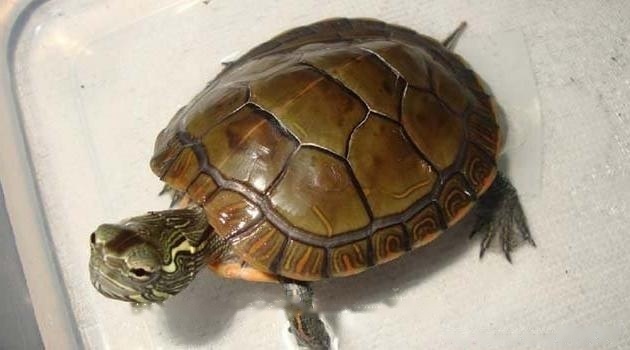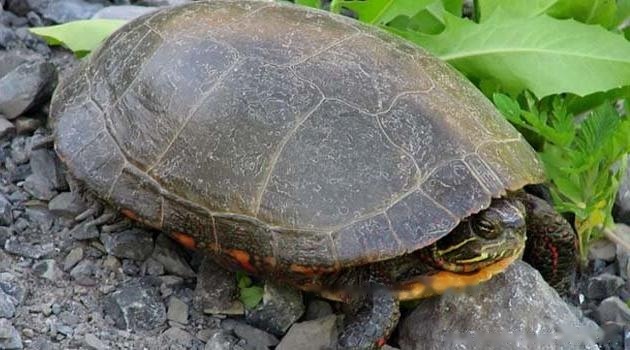The central painted turtle, found from Canada to the eastern Great Lakes to southern Illinois, among the painted turtle subspecies, in Transition stage for the other three subspecies. The color markings on the head are not completely linear (the lines are not as complete as those of Xi and Nan Jin), and the first two spread all the way to the eyes. It's like this from juvenile to adult. The back is green, with a small number of patterns on the edges similar to those of Western brocade, and there are still a small number of parallel lines on the stomach, with oval-like patterns. The shape of the pattern of the larval and adult belly varies. Painted turtles are the most widely distributed of the North American aquatic turtles, and are the only ones found from southern Canada to northern Mexico, and from the northwestern to southeastern United States, and their range covers the entire North American continent.

The carapace of the middle painted turtle is 10-25 cm long, and it is a small aquatic turtle. The carapace is smooth, flat oval, green to black in color, and erythematous in some subspecies. The plastron is generally yellow, sometimes tinged with red, and sometimes black to reddish-brown with patterns of varying size and shape. Painted turtles have black to olive skin with yellow and red stripes on the neck, limbs and tail, and yellow stripes on the head. Male tortoises have elongated front claws and a thick, long tail. Female turtles are generally larger in size, with shorter front claws and shorter and thinner tails.
The Painted Turtle They are found from southern Canada to northern Mexico, and from the northwestern to southeastern United States, and their range covers the entire North American continent. Because of their extremely widespread distribution, they are found in the coldest and warmest places in the United States during winters. The northernmost subspecies hibernates regularly and for longer periods of time than the southern subspecies. The southern painted turtles and western painted turtles living in the southern end of the distribution area may not hibernate.
They like ponds, swamps, creeks and lakes where the flow is slow and the bottom It is covered with soft silt and has suitable sunbathing sites and abundant aquatic plants. Painted turtles are diurnal and sleep at night on the bottom of pools or on partially submerged objects. They become active when the sun rises, bask on their backs for a few more hours, and then forage for food late in the morning. By evening they may be foraging again.

The central painted turtle is omnivorous, and in their habitat, various animals and plants, regardless of Life and death will become their meals. This includes: snails, slugs, insects, crayfish, tadpoles, small fish, carrion, algae and aquatic plants. Young painted turtles are carnivorous, while older painted turtles tend to be more herbivorous as they age. Painted turtles are often kept as pets due to their small size and adaptability to captivity. They have funny personalities and make funny moves from time to time. Painted turtles can be housed in aquariums around 4 feet and are equipped with UV lamps, incandescent lamps, heaters, filters, and basking platforms and shelters made of rock with pebbles underneath.
Nesting occurs from May to mid-July. Female turtles will nest in sunny locations near water, requiring slightly moist loamy or sandy soil, and nests in the shape of a flask. The number of eggs laid varies from 2 to 20, depending on the subspecies. Under natural conditions and in artificial rearing, the average incubation period is 76 days. The effect of incubation temperature on the sex of hatchlings is evident in painted turtles. When the temperature is relatively warm (87°F, 30.5°C), the female turtle hatches from the eggs. Males are produced in cooler temperatures (77°F, 25°C). At an intermediate temperature of 84°F (29°C), both females and males hatch. Juveniles break out of their eggs with the help of broken egg teeth. Broken egg teeth fall off within a few days of hatching. Juveniles have ridges on the back and folds on the abdomen, which disappear when they grow up. The colors and markings on their carapace are brighter and more pronounced than in adult turtles. They reach maturity within five years of hatching, while they are thought to live up to 20 years.
![[Dog Training 5] The training method of pet dog dining etiquette](/static/img/12192/12192_1.jpg)





